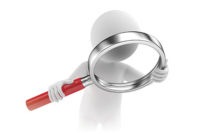By developing a PC-based metrology system with the computing horsepower to handle the task, Turbine Metrology (Kansas City, MO) can find problems early in the production process, and is saving on rework costs--up to $150,000 per rotor.
Rotating parts of a turbine rotor unit range up to 96 inches in diameter, 120 inches in length and weigh up to 25,000 pounds. Approximately 24 of these components are stacked up and bolted together during assembly to form the spinning core of the power generator unit. The accuracy of these components is critical to the performance of the finished unit. If each part is only a few thousands of an inch out of flat, the accumulated tolerances will result in a "stack" in which the bearing surfaces are out of alignment, leading to premature bearing wear and possibly catastrophic failure.
Current manufacturing meth-ods make it virtually impossible to build these massive parts to small enough tolerances that they can be simply bolted together with-out inspection. Instead, turbine manufacturers attempt to accurately measure each of the many rotors in the assembly and then match them up based on their flatness measurements in such a way that the entire stack will run true. Restacking an assembled rotor can cost up to $150,000, so the measurements are critical, notes Neill Fleeman, technical director for Turbine Metrology.
A large number of data points need to be collected to accurately determine runout, concentricity, eccentricity and flatness of the parts. Turbine Metrology developed a system called the Paragon, which is a workstation that uses precision air bearing rotary inspection tables from Eimeldingen Ltd. (Bath, Britian), encoders from Heidenhain Corp. (Schaumburg, IL) and four electronic lever-type gage heads from Brown and Sharpe (North Kingstown, RI). This system takes more than 1.2 million samples per second in a single revolution the part, creating a need for a system that could quickly and efficiently process vast amounts of data.
"The mechanical aspects of the process are difficult. These large and heavy rotors must be centered and rotated accurately enough to prevent their runout from affecting the measurements," Fleeman observes. But the hardest part, he says, is "processing the enormous volume of data required to thoroughly characterize parts of these sizes while eliminating the influence of external seismic and acoustic inputs."
To handle this job in the Paragon system, Turbine Metrology chose an iDSC 1816 data acquisition processor (DAP) board supplied by Microstar Laboratories (Bellevue, WA). The board simultaneously collects and processes eight channels of data in 16-bit resolution without requiring any low-level attention from the host PC. According to Fleeman, a unique capability of the DAP is an onboard microprocessor that runs a multitasking, real-time operating system, optimized for high performance data acquisition and control applications. The board extends the power of the Windows interface by executing all processor-intensive routines in real time, so the software can handle more demanding applications.
"The net result is a sys-tem that can fully character-ize the turbine rotors with respect to runout, eccentricity, concentricity and flatness by collecting 720,000 measurements in a single revolution," says Fleeman. "With this system, manufacturers of the rotors can accurately determine the dimensions early on in the manufacturing process."
Microstar Laboratories Inc.
(425) 453-2345
www.mstarlabs.com
